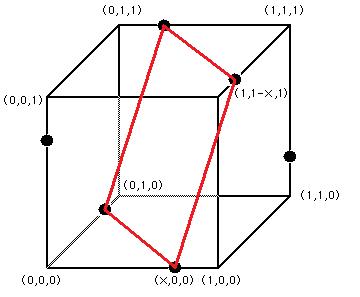Difference between revisions of "2012 AMC 12B Problems/Problem 19"
(Created page with "==Solution== File:2012_AMC-12B-19.jpg Observe the diagram above. Each dot represents one of the six vertices of the regular octahedron. Three dots have been placed exact...") |
Humzaiqbal (talk | contribs) |
||
| Line 3: | Line 3: | ||
[[File:2012_AMC-12B-19.jpg]] | [[File:2012_AMC-12B-19.jpg]] | ||
| − | Observe the diagram above. Each dot represents one of the six vertices of the regular octahedron. Three dots have been placed exactly x units from the (0,0,0) corner of the unit cube. The other three dots have been placed exactly x units from the (1,1,1) corner of the unit cube. A red square has been drawn connecting four of the dots to provide perspective regarding the shape of the octahedron. Observe that the three dots that are near (0,0,0) are each x | + | Observe the diagram above. Each dot represents one of the six vertices of the regular octahedron. Three dots have been placed exactly x units from the (0,0,0) corner of the unit cube. The other three dots have been placed exactly x units from the (1,1,1) corner of the unit cube. A red square has been drawn connecting four of the dots to provide perspective regarding the shape of the octahedron. Observe that the three dots that are near (0,0,0) are each (x)(<math>\sqrt{2}</math>) from each other. The same is true for the three dots that are near (1,1,1). There is a unique x for which the rectangle drawn in red becomes a square. This will occur when the distance from (x,0,0) to (1,1-x, 1) is (x)(<math>\sqrt{2}</math>). |
| − | Using the distance formula we find the distance between the two points to be: sqrt | + | Using the distance formula we find the distance between the two points to be: <math>\sqrt{{(1-x)^2} + {(1-x)^2} + 1}</math> = <math>\sqrt{2x^2 - 4x +3}</math>. Equating this to (x)(<math>\sqrt{2}</math>) and squaring both sides, we have the equation: |
| − | + | <math>2{x^2}</math> - <math>4x + 3</math> = <math>2{x^2}</math> | |
| − | -4x + 3 = 0 | + | <math>-4x + 3 = 0</math> |
| − | x = 3/ | + | <math>x</math> = <math>\frac{3} {4}</math>. |
| − | Since the length of each side is x | + | Since the length of each side is (x)(<math>\sqrt{2}</math>), we have a final result of <math>\frac{3 \sqrt{2}}{4}</math>. Thus, Answer choice A is correct. |
Revision as of 00:50, 27 February 2012
Solution
Observe the diagram above. Each dot represents one of the six vertices of the regular octahedron. Three dots have been placed exactly x units from the (0,0,0) corner of the unit cube. The other three dots have been placed exactly x units from the (1,1,1) corner of the unit cube. A red square has been drawn connecting four of the dots to provide perspective regarding the shape of the octahedron. Observe that the three dots that are near (0,0,0) are each (x)(![]() ) from each other. The same is true for the three dots that are near (1,1,1). There is a unique x for which the rectangle drawn in red becomes a square. This will occur when the distance from (x,0,0) to (1,1-x, 1) is (x)(
) from each other. The same is true for the three dots that are near (1,1,1). There is a unique x for which the rectangle drawn in red becomes a square. This will occur when the distance from (x,0,0) to (1,1-x, 1) is (x)(![]() ).
).
Using the distance formula we find the distance between the two points to be: ![]() =
= ![]() . Equating this to (x)(
. Equating this to (x)(![]() ) and squaring both sides, we have the equation:
) and squaring both sides, we have the equation:
![]() -
- ![]() =
= ![]()
![]()
![]() =
= ![]() .
.
Since the length of each side is (x)(![]() ), we have a final result of
), we have a final result of ![]() . Thus, Answer choice A is correct.
. Thus, Answer choice A is correct.
(If someone can draw a better diagram with the points labeled P1,P2, etc., I would appreciate it).
--Jm314 14:55, 26 February 2012 (EST)










